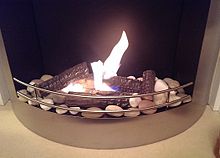Ethanol fireplace

An ethanol fireplace (also bio-ethanol fireplace, bio fireplace), is a type of fireplace which burns ethanol fuel. They are often installed without a chimney. Ethanol for these fires is often marketed as bioethanol (ethanol produced from biomass).[clarification needed]

The main part of the fireplace is the burner. The burner is a container filled with fuel. Ethanol fireplaces should be operated with care, since ethanol is highly flammable,[1][2][3] and severe burn accidents can happen,[1][4] mostly while refilling or lighting the fireplace, even when safety instructions are followed.[5]
Emissions from ethanol fireplaces include carbon dioxide and nitrogen dioxide, volatile organic compounds, and particulate emissions, which are released into the room.[6] Ethanol fireplaces — irrespective of the type of fuel used — are a source of fine and ultrafine particles and have a considerable influence on the quality of the indoor air; ventilation reduces the effect.[6] Ethanol may also generate odors.[7] Burning hydrocarbons causes indoor air pollution. Emissions include airborne particulate matter (such as black carbon) and nitrogen oxides. These harm health; some forms of fuel are more harmful than others.[8]
Types[]
Ethanol fireplaces are available in several different designs. There are manual ethanol fireplaces and automatic ethanol fireplaces. Automatic ethanol fireplace flames have no direct user contact with fuel. Fuel is in stored in a reservoir and then heated until the alcohol evaporates into the burner. These vapors are then ignited by a spark system in the unit. User can turn the flames on or off as well as regulate the flame size with a remote control, mobile app or smart home system. A microprocessor controls burning process, using numerous sensors to keep burning parameters stable. If the sensors detect any issues — such as an earth quake, low oxygen or excessively high temperatures — they will extinguish the flame. Wall mounted designs can be built into a drywall wall or be recessed into the wall. Free standing or stand-alone ethanol fireplaces are portable, and can be used in any architectural setting. Table-top ethanol fireplaces are the smallest versions of ethanol fireplaces and are often used as a decoration.
See also[]
References[]
- ^ Jump up to: a b Kraemer, R; Knobloch, K; Lorenzen, J; Breuing, K. H.; Koennecker, S; Rennekampff, H. O.; Vogt, P. M. (2011). "Severe burn injuries caused by bioethanol-design fireplaces-an overview on recreational fire threats". Journal of Burn Care & Research. 32 (2): 173–7. doi:10.1097/BCR.0b013e31820aade7. PMID 21233730.
- ^ Ethanol fireplaces: The underestimated risk. Science Daily (3 September 2014)
- ^ Warning About Use of Bio Ethanol Fuel Archived 8 December 2015 at the Wayback Machine. Staffordshire Fire and Rescue Service
- ^ Heald, Alicia; Muller, Michael (2016). "Severe burns due to biofuel heater injury: A case series". Burns. 42 (2): e13–e17. doi:10.1016/j.burns.2015.04.013. PMID 26122559.
- ^ Neubrech, Florian; Kiefer, Jurij; Schmidt, Volker J.; Bigdeli, Amir K.; Hernekamp, J. Frederick; Kremer, Thomas; Kneser, Ulrich; Radu, Christian Andreas (2016). "Domestic bioethanol-fireplaces–a new source of severe burn accidents". Burns. 42 (1): 209–214. doi:10.1016/j.burns.2015.10.004. PMID 26518753.
- ^ Jump up to: a b Schripp, Tobias; Salthammer, Tunga; Wientzek, Sebastian; Wensing, Michael (18 March 2014). "Chamber Studies on Nonvented Decorative Fireplaces Using Liquid or Gelled Ethanol Fuel". Environmental Science & Technology. 48 (6): 3583–3590. Bibcode:2014EnST...48.3583S. doi:10.1021/es404972s. ISSN 0013-936X. PMID 24517295.
- ^ Nozza, Elena; Capelli, Laura; Eusebio, Lidia; Derudi, Marco; Nano, Giuseppe; Rosso, Renato Del; Sironi, Selena (2016). "The role of bioethanol flueless fireplaces on indoor air quality: Focus on odour emissions". Building and Environment. 98: 98–106. doi:10.1016/j.buildenv.2016.01.004. hdl:11311/1000838.
- ^ Apte, K; Salvi, S (2016). "Household air pollution and its effects on health". F1000Research. 5: 2593. doi:10.12688/f1000research.7552.1. PMC 5089137. PMID 27853506.
Burning of natural gas not only produces a variety of gases such as sulfur oxides, mercury compounds, and particulate matter but also leads to the production of nitrogen oxides, primarily nitrogen dioxide...The burning of biomass fuel or any other fossil fuel increases the concentration of black carbon in the air...[rest of material in linked fulltext]
- Fireplaces
- Light sources
- Ethanol fuel
- Energy stubs